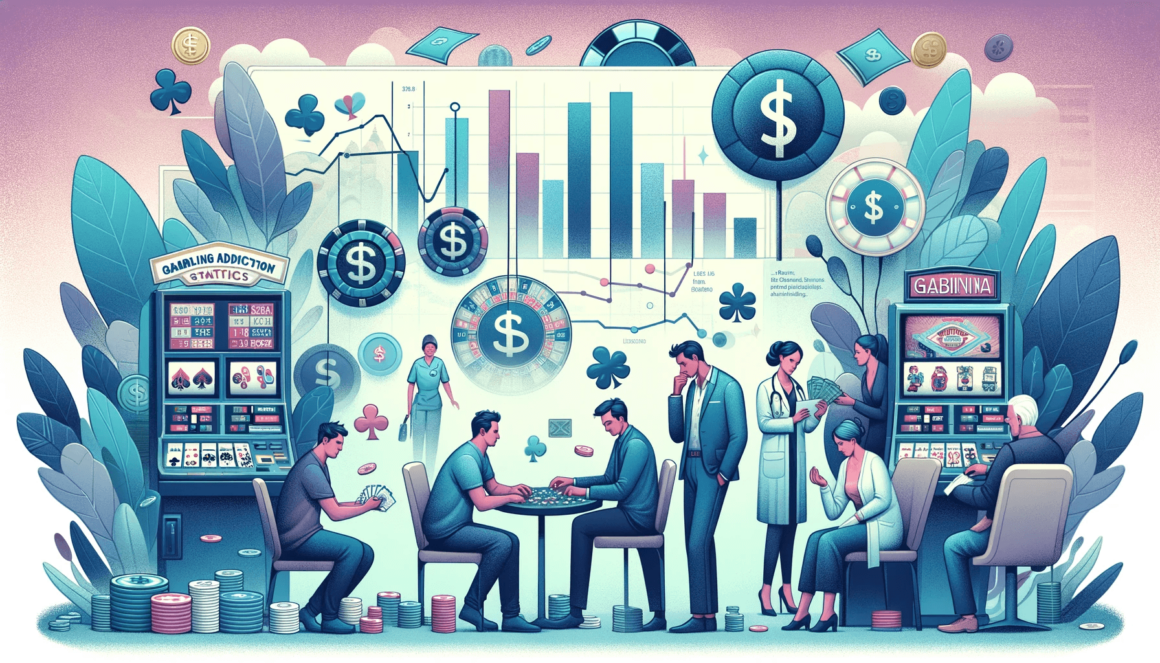Gambling Addiction Statistics: Problem Gambling on the Rise
Gambling can be fun, but gambling addiction statistics show a grimmer side of the industry and human nature.
As you will see from these stats that we’ve gathered, we’re talking about a global health concern that wreaks not only physical and psychological but financial havoc as well.
Top 10 Gambling Addiction Facts and Stats You Need to Know
- The percentage of Americans with a severe addiction problem stands at 1%.
- An estimated 23 million Americans go into debt because of gambling.
- US citizens spend around $500 billion on wages every year.
- According to gambling addiction facts, 0.5% of UK adults are problem gamblers.
- Gambling problems cost the UK $369 million to $1.7 billion a year.
- In 2018, 0.6% of the population in Canada were considered problem gamblers.
- China’s first rehab center for gamblers gets around 50 new patients each month.
- Only 1% of women who’ve experienced gambling-caused harm will ask for help.
- 1.9% of 11–16 year-olds from England and Scotland are problem gamblers.
- 2.1% of US residents ages 14–21 struggle with gambling problems.
Gambling Addiction Statistics in the US

Considering Sin City’s casino industry stats, one might think that the United States has the most problems with gambling addicts. Let’s see the numbers and just how problematic the gambling scene in America is.
1. Of all people with gambling addiction, the percentage of Americans with a severe addiction problem stands at 1%
(NBC News)
This includes about 2.5 million Americans. Just keep in mind that statistics on gambling addiction can be a little off since not all with a problem seek help and treatment. This is mainly because gambling doesn’t show physically, unlike alcohol and tobacco addictions.
2. Facts about compulsive gambling reveal that an estimated 3 million American adults are at risk of becoming compulsive gamblers.
(Genius)
Also, around 15 million adults are at risk of becoming problem gamblers, and a total of 148 million citizens fall under the low-risk gambler category. It’s also important to mention that more than 80% of adult Americans gamble every year.
3. An estimated 23 million Americans go into debt because of gambling, according to casino gambling addiction statistics.
(Dep.org)
The same gambling addiction stats also estimate that the average loss is around $55,000.
Unfortunately, many people try to pay back the loss by investing even more money, hoping to land a huge win. This is extremely risky, though, and very often results in even more significant debt.
4. Gambling addiction statistics in America reveal that around 15% of US citizens gamble on a weekly basis.
(Dep.org)
According to their findings, around 6 million adults in the US fall into the category of “problem gamblers.” Even more alarming is the fact that 500,000 teenagers also meet the criteria.
5. US citizens spend around $500 billion on wages every year.
(Genius)
Additionally, around 750,000 young people from age 14 to 21 have a gambling addiction.
This shows that people usually start gambling early — and that stopping is as difficult as with any other addiction.
Gambling Addiction Statistics Worldwide
It’s not just the US that has to deal with this problem — it’s also prevalent in Europe, Africa, and Asia. The numbers are pretty alarming across the board.
6. Gambling addiction statistics show that around 88,000 UK college students are problem gamblers.
(Top Universities)
Furthermore, their stats on gambling addiction show that half of those who managed to generate debt had an excess of around $1,295 (£1,000).
7. An estimated 0.5% of UK adults are problem gamblers, according to gambling addiction stats.
(Finder)
Gambling problem facts about Britain also conclude that 3.1% of these problem gamblers have bet more than they can afford to lose.
Moreover, 7% of gamblers said they gamble to “earn money to get by day-to-day.”
8. Stats on gambling addictions show that the disorder costs the UK $369 million to $1.7 billion a year.
(Finder)
When broken down to averages, Brits are spending about $3.70 per week on gambling. This might not sound like much, but keep in mind that these numbers pile up over time.
9. Facts about compulsive gambling show that between 2017 and 2018, Australians lost a total of $19.19 million on gambling.
(Savings, Savings)
When looking at gambling addiction statistics in Australia, the same report from the Queensland Treasury found a 5% increase from the total gambling loss of the year before.
If we take all the adult Australians (based on census data) and spread out the losses, every adult who’s 18 or older would have a gambling loss of roughly $9,250.
10. Sports gambling addiction statistics reveal that in Nigeria, around 60 million people from 18 to 40 bet on sports daily.
(South World)
Gambling addiction facts and statistics from Nigeria further show that its people spend as much as $5 million on sports betting every day.
This further affects the already quite jaw-dropping sports betting stats.
11. Around 54% of young people in the Sub-Saharan region have tried gambling.
(South World)
The Geopoll research shows that Kenya takes the lead in this respect, with 76% of young people testing their fortune in such a way.
They are followed by Ugandans and Ghanaians, at 57% and 42%, respectfully.
12. Gambling problem facts show that in 2019, Japan’s recovery centers had 5,222 calls related to gambling addiction.
(Statista)
A year before, gambling addiction stats showed that recovery centers received a total of 5,795 calls, being the highest number recorded in the 2010–2019 period.
The lowest was in 2011mselves. Who are they? How old are they? Is gambling only a “male thing,” or are women at risk too? What do they with only 1,027.
13. In 2018, only 0.6% of the population in Canada were considered problem gamblers.
(Williams Gambling)
The research data also shows that around 2.7% of the population can be defined as “at-risk” gamblers.
These latest gambling addiction statistics from Canada also show that, compared to the study on the same topic conducted back in 2002, the numbers show a 45% decrease in the overall prevalence of problem gambling.
14. China’s first rehab center for gamblers receives around 50 new patients each month.
(South China Morning Post)
Additionally, the center has helped thousands over the past dozen years.
Gambling addicts across mainland China primarily access offshore websites and apps to play and fuel their needs. Around 70% of these sites are based in the Philippines.
In the country, only the state-run lottery is permitted as far as gambling goes.
Gambling Disorder Statistics — Demographics
Lastly, a few words about the gamblers themselves. Who are they? How old are they? Is gambling only a “male thing,” or are women at risk too? What do they do to fight their addiction?
Let’s find out.
15. Gambling support networks estimate that only 1% of women who’ve experienced gambling-caused harm will reach out for help.
(Gamcare)
According to accumulated gamblers anonymous statistics and helpline data from 2019, women are more likely to call about others’ gambling issues than their own.
More precisely, 90% of men call because of their own gambling problems, while only 41% of women call for the same reason.
16. GamCare, a gambling charity, received a total of 38,404 calls between 2019 and 2020.
(BBC)
The stats also show that the callers were either 35 or younger in six out of ten cases. This age group is also the most likely one to actually get treatment.
17. Around 80 to 90% of Gamblers Anonymous attendees admitted to engaging in illegal acts to get gambling money.
(The Recovery Village)
When it comes to problem gamblers statistics and criminal behaviors, data from Gamblers Anonymous shows that around 63% of the members reported writing bad checks.
Furthermore, approximately 30% said that they’ve stolen from work.
18. British compulsive gambling facts show that 29.3% of surveyed adults between the ages of 35 and 44 gamble regularly.
(Statista)
More precisely, they gamble at least once every four weeks. The second-largest age group in this survey were the 45–54 year-olds.
Online gambling addiction statistics show that from that group, 25.4% of the respondents gamble at least once every month, contributing to the latest online gambling stats.
19. According to gambling disorder statistics, 1.9% of 11–16 year-olds from England and Scotland fall into the category of problem gamblers.
(Gambling Commission)
Furthermore, another 2.7% are “at-risk” gamblers, with 37% of the entire age group having gambled in the last 12 months before participating in the survey, according to the same gambling addiction statistics from 2019.
20. According to NCPG research, 2.1% of US residents ages 14–21 struggle with gambling problems.
(NYCPG)
Also, the same research results show that another 6.5% are at-risk. Furthermore, stats indicate that 90% of surveyed high school students have gambled at least once in the 12 months preceding the research.
Conclusion
All in all, these gambling addiction statistics show that this problem is a genuine health concern affecting millions across the globe directly and even more indirectly.
Addictive gambling may lead to severe financial difficulties, ruin relationships with relatives, family, and friends. In more severe cases, even lead to a lifestyle of crime.
Those who suspect that they also may be prone to this behavior shouldn’t hesitate to reach out for help if they feel the need to do so.
FAQ
What are the signs of gambling addiction?
The most obvious signs of having a gambling addiction include being overly preoccupied with gambling and increasing the wagers to get the same sense of thrill.
Also, making futile efforts to stop or reduce gambling, with the classic withdrawal symptoms like irritability. Gambling to escape problems and to get back lost money are also frequent signs.
Jeopardizing relationships because of gambling, lying about the problem, and committing crimes to get gambling money are also common symptoms of the problem.
Why is gambling so addictive?
According to Dr. Cyrus Abbassin, an addiction specialist from London, it’s all about human nature. People’s brains are designed to seek rewards. In this case, it is the chemical called dopamine that makes us feel good.
In prehistoric times, we experienced dopamine surges after successful hunting. A primitive part of the human brain is still hardwired for this immediate reward buzz.
As such, some people tend to gamble to eventually win, so our brain gets the dopamine buzz. However, for some, this buzz becomes more.
Compulsive gambling statistics show that those who become hooked — always searching for that same high — start to lose interest in other activities.
Unfortunately, there’s a genetic contribution to it, meaning that some people are simply predisposed to develop such addictions.
What percentage of the world has a gambling addiction?
Assessing the total number of addicts is incredibly difficult, mainly because some people may never seek treatment.
However, older statistics from the North American Foundation for Gambling Addiction Help state that around 10 million people in the US struggle with gambling problems.
The problem is similar in Europe as well. In the UK, around 430,000 people are addicted to gambling. In Sweden, the number of female gambling addicts has increased, which now equals 64%. In Switzerland, 3% of the population gambles too much.
Problem gambling stats also show that in Africa, young adults from 17–35 from Kenya, Uganda, South Africa, Ghana, Nigeria, and Tanzania are regular gamblers. With Kenya having the highest youth gambler rates (76%). On the opposite end is Ghana with 42%.
Lastly, in Asia, determining the actual number of problematic gamblers becomes almost impossible since deep cultural factors encourage the activity and discourage seeking help when it becomes addictive.
Older data states that three Asia-Pacific countries had the most significant gambling losses per adult worldwide in 2017.
Can you overcome gambling addiction?
Just like with any other addiction, you can overcome it. It won’t necessarily be easy, but it can be done.
First, you need to admit that you have a problem. Second, joining a support group can ease your stress, and you can also choose to visit cognitive-behavioral therapists. Medication (antidepressants) prescribed by a professional, if necessary, may also help.
Lastly, implementing regulatory mechanisms, like entrusting an advisor to control your finances, may be a good idea.
Is gambling a mental illness?
To be precise, compulsive gambling is a progressive addiction that’s officially classified as an impulse-control disorder.
Compulsive gambling facts reveal that gambling is included in the fifth edition of the American Psychiatric Association (APA’s) Diagnostic and Statistical Manual.
Gambling, or any other addiction, can be harmful to one’s physical and psychological health.
 BC.Game
BC.Game  7Bit
7Bit  Ducky Luck
Ducky Luck  Red Dog
Red Dog